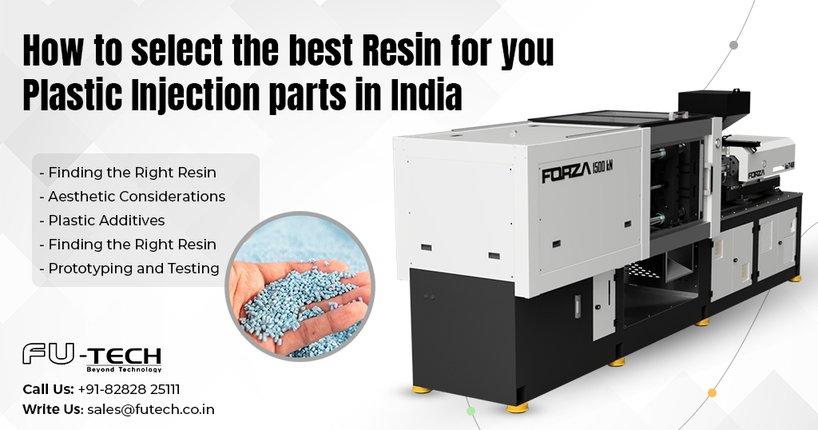How to select the best resin for you plastic injection parts in India
Choosing the right resin for your plastic injection parts is a critical step that impacts the performance, aesthetics, and compliance of the final product
Choosing the right resin for your plastic injection parts is a critical step that impacts the performance, aesthetics, and compliance of the final product. With a plethora of options available in the Indian market, it’s essential to consider various factors to ensure the best fit for your needs. This blog will guide you through the key considerations and steps involved in selecting the best resin for your plastic injection parts in India.

What is the Intended Purpose of the Final Part?
The primary function of the part dictates the necessary properties of the resin. Consider the following questions:
- Load-bearing Requirements: Does the part need to withstand significant mechanical stress or impact?
- Environmental Exposure: Will the part be exposed to harsh environments, such as extreme temperatures, UV radiation, or chemicals?
- Longevity and Durability: What is the expected lifespan of the part, and does it need to maintain its properties over time?
Understanding the specific demands of the application helps narrow down the resin options that can meet those needs effectively.
Are There Special Aesthetic Considerations?
Aesthetic requirements can influence the choice of resin significantly. Consider the following:
- Color and Transparency: Does the part need to be a specific color or transparent?
- Surface Finish: What type of surface finish is required—smooth, textured, glossy, or matte?
- Branding Needs: Are there any branding elements that require special attention to detail in terms of color matching or surface quality?
Some resins naturally offer better aesthetic properties, such as clarity or the ability to take on vibrant colors, which can be a deciding factor in your selection process.
Do Any Regulatory Requirements Apply?
Regulatory compliance is crucial, especially for parts used in specific industries such as medical, automotive, and food packaging. Check if your part needs to meet any of the following standards:
- FDA Compliance: For parts used in food contact applications or medical devices.
- RoHS Compliance: For parts used in electronic devices to ensure they are free of hazardous substances.
- ISO Standards: Depending on the industry, there might be specific ISO standards that your part needs to adhere to.
Ensuring compliance with relevant regulations is essential to avoid legal issues and ensure market acceptance.
Finding the Right Resin
With a clear understanding of the part’s purpose, aesthetic needs, and regulatory requirements, you can start evaluating potential resins. Here are some commonly used resins in India and their key properties:
- Polypropylene (PP): Versatile, cost-effective, good chemical resistance.
- Polyethylene (PE): High impact resistance, excellent chemical resistance.
- Acrylonitrile Butadiene Styrene (ABS): Excellent impact resistance, good mechanical strength.
- Polycarbonate (PC): High impact strength, excellent optical clarity.
- Nylon (Polyamide): Good mechanical properties, high-temperature resistance.
- Polyethylene Terephthalate (PET): High strength, excellent wear resistance.
- Polystyrene (PS): Low cost, good dimensional stability.
Plastic Additives to Improve Characteristics
Sometimes, the base resin alone may not meet all your requirements. Plastic additives can enhance the properties of the resin, making it more suitable for your application. Common additives include:
- UV Stabilizers: To improve resistance to UV radiation and prevent degradation.
- Flame Retardants: To enhance fire resistance.
- Plasticizers: To increase flexibility and reduce brittleness.
- Colorants: To achieve specific colors or effects.
- Reinforcements: Such as glass fibers to improve strength and stiffness.
Adding these compounds can tailor the resin to better suit your specific needs.
The Final Selection
After evaluating all the factors and options, the final step involves prototyping and testing. This helps ensure that the selected resin and additives perform as expected in real-world conditions. Steps to finalize your selection include:
- Material Testing: Conduct mechanical, thermal, and chemical tests to validate the performance of the resin.
- Prototype Development: Create a prototype of the part to assess its functionality and aesthetics.
- Supplier Consultation: Work closely with suppliers to understand the processing requirements and ensure consistent quality.
Conclusion
Selecting the best resin for your plastic injection moulding parts in India is a meticulous process that requires careful consideration of the part’s purpose, aesthetic needs, regulatory compliance, material properties, and potential additives. By following a systematic approach and leveraging local supplier expertise, you can make an informed decision that ensures the success of your injection molding project and delivers high-quality, compliant, and aesthetically pleasing parts.
No comments yet. Login to start a new discussion Start a new discussion